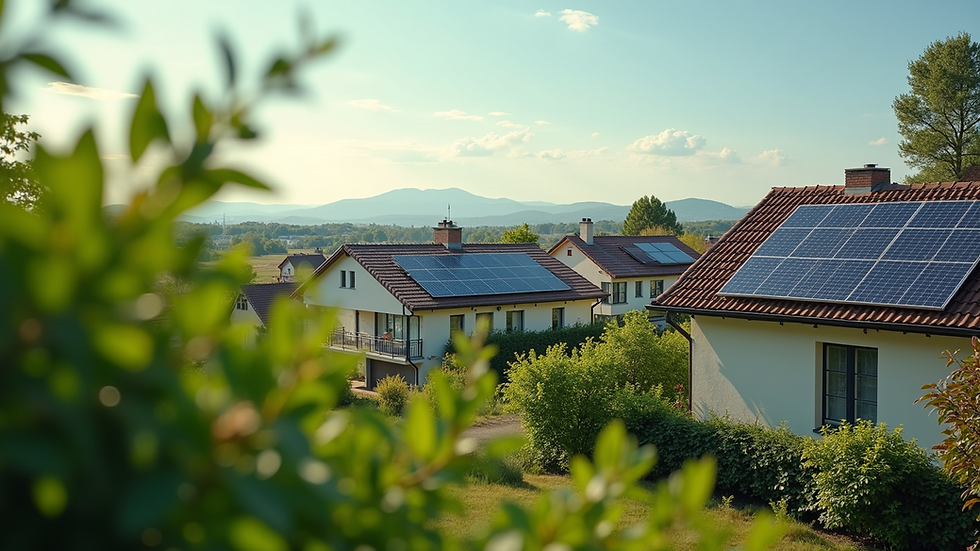Discover How Hereafter Communities Foster Sustainability
- Hereafter Farms
- 4 days ago
- 4 min read
Sustainability is no longer just a buzzword; it is a necessity for the future of our planet. Communities around the world are adopting new ways to live that reduce environmental impact, promote social well-being, and create economic resilience. One inspiring example is the rise of hereafter communities, which integrate sustainable practices into daily life. These communities focus on shared resources, eco-friendly infrastructure, and a strong connection to nature. This article explores how such communities foster sustainable community living and offers practical insights for anyone interested in this lifestyle.
Embracing Sustainable Community Living: What It Means and Why It Matters
Sustainable community living is about creating environments where people can thrive without depleting natural resources or harming the ecosystem. It involves designing neighborhoods and social systems that prioritize renewable energy, waste reduction, water conservation, and local food production. The goal is to balance human needs with the health of the planet.
Key elements of sustainable community living include:
Energy Efficiency: Using solar panels, wind turbines, and energy-saving appliances.
Waste Management: Implementing recycling, composting, and zero-waste initiatives.
Water Conservation: Collecting rainwater, using greywater systems, and planting drought-resistant gardens.
Local Food Systems: Growing food locally through community gardens, farms, and farmers markets.
Social Cohesion: Encouraging shared spaces, cooperative decision-making, and community events.
By adopting these principles, communities reduce their carbon footprint and build resilience against environmental challenges.

Solar panels on rooftops provide clean energy for sustainable neighborhoods.
How Hereafter Communities Lead the Way in Sustainability
The hereafter community model exemplifies sustainable community living by integrating innovative solutions with traditional values. These communities are designed to be self-sufficient, environmentally responsible, and socially inclusive.
Practical Features of Hereafter Communities
Renewable Energy Systems: Many hereafter communities rely on solar and wind energy to power homes and communal facilities.
Eco-Friendly Building Materials: Structures are built using recycled, natural, or low-impact materials to minimize environmental harm.
Shared Resources: Residents share tools, vehicles, and appliances, reducing waste and consumption.
Permaculture and Organic Farming: Food is grown using sustainable agricultural methods that enhance soil health and biodiversity.
Water Management: Advanced systems capture and recycle water, reducing dependence on municipal supplies.
Social and Economic Benefits
Community Engagement: Regular meetings and events foster a sense of belonging and collective responsibility.
Cost Savings: Shared resources and energy-efficient designs lower living expenses.
Health and Well-being: Access to green spaces and fresh food improves physical and mental health.
These features make hereafter communities a blueprint for future sustainable living.

Community gardens provide fresh, organic produce and strengthen neighborhood bonds.
What is a Farming Community Called?
A farming community is often referred to as an agricultural community or agrarian community. These communities are centered around farming activities and rural lifestyles. They typically focus on cultivating crops, raising livestock, and managing natural resources sustainably.
Agricultural communities have historically been the backbone of human civilization, providing food and raw materials. In modern sustainable living contexts, farming communities are evolving to incorporate eco-friendly practices such as:
Crop Rotation: Enhances soil fertility and reduces pests.
Organic Farming: Avoids synthetic pesticides and fertilizers.
Agroforestry: Combines trees and crops to improve biodiversity.
Community-Supported Agriculture (CSA): Connects farmers directly with consumers to promote local food systems.
These practices align closely with the goals of sustainable community living by promoting environmental stewardship and food security.
Steps to Create Your Own Sustainable Community
Building a sustainable community requires careful planning, collaboration, and commitment. Here are actionable steps to get started:
Assess Local Resources and Needs: Understand the natural environment, climate, and community demographics.
Engage Stakeholders: Involve residents, local authorities, and experts in the planning process.
Design for Sustainability: Incorporate renewable energy, water conservation, and green building techniques.
Develop Shared Spaces: Create parks, gardens, and community centers to encourage social interaction.
Implement Waste Reduction Programs: Promote recycling, composting, and minimal packaging.
Support Local Food Production: Establish community gardens, farmers markets, or cooperative farms.
Educate and Empower Residents: Offer workshops on sustainable living practices and encourage participation.
By following these steps, communities can transition toward a more sustainable and resilient future.
The Future of Sustainable Community Living
Sustainable community living is gaining momentum as more people recognize the importance of environmental responsibility and social connection. Innovations in technology, urban planning, and agriculture are making it easier to build communities that are both eco-friendly and vibrant.
Hereafter communities serve as inspiring examples of what is possible when sustainability is prioritized. They demonstrate that living in harmony with nature is achievable and beneficial for all.
As awareness grows, more neighborhoods and towns will likely adopt sustainable practices, creating a network of communities dedicated to preserving the planet for future generations.

Green roofs and solar panels are key features of future sustainable neighborhoods.
Sustainable community living is not just a trend but a necessary shift toward a healthier, more equitable world. By learning from successful models like hereafter communities and taking practical steps, anyone can contribute to this important movement.
.png)



Comments